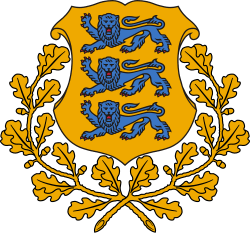German-Baltic Party
 |
| This article is part of a series on the politics and government of Estonia |
The German-Baltic Party (Estonian: Saksa-Balti erakond; German: Deutsch-baltische Partei in Estland, DbPE) was a political party in Estonia representing the German minority.
History
The party was established on 27 November 1918 under the name German Party in Estonia (German: Deutsche Partei in Estland, Estonian: Saksa Erakond Eestimaal) in preparation for the Constituent Assembly elections the following April. Following the Estonian War of Independence, the party was renamed the German-Baltic Party.
The party won three seats in the elections in April 1919.[1] In the parliamentary elections in 1920 it won four seats, but was reduced to three seats in the 1923 elections and two seats in the 1926 elections.[2] For the 1929 elections the party formed the German-Swedish Bloc,[3] winning three seats.[2] This was continued for the 1932 elections, with the bloc again winning three seats.
List of MPs
| Parliament | Members | Notes |
|---|---|---|
| 1919–20 | Max Bock | Chairman |
| Hermann Koch | ||
| Johannes Meyer | Replaced by Georg von Stackelberg on 27 January 1920 | |
| 1920–1923 | Max Bock | Chairman |
| Hermann Koch | ||
| Walter Petzold | ||
| Georg von Stackelberg | ||
| 1923–1926 | Werner Hasselblatt | Chairman |
| Carl von Schilling | ||
| Martin Christian Luther | Replaced by Gerhard Kreß on 1 October 1923, replaced by Axel de Vries on 9 April 1924 | |
| 1926–1929 | Werner Hasselblatt | Chairman |
| Carl von Schilling | ||
| 1929–1932 | Carl von Schilling | Chairman |
| Werner Hasselblatt | ||
| Hans Pohl | Swedish, replaced by Mathias Westerblom on 22 January 1930 | |
| 1932–1934 | Carl von Schilling | Chairman |
| Hermann Koch | ||
| Mathias Westerblom | Swedish |